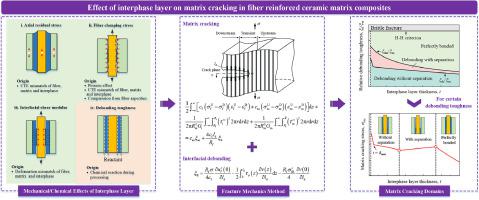当前位置:
X-MOL 学术
›
J. Mech. Phys. Solids
›
论文详情
Our official English website, www.x-mol.net, welcomes your feedback! (Note: you will need to create a separate account there.)
Effect of interphase layer on matrix cracking in fiber reinforced ceramic matrix composites
Journal of the Mechanics and Physics of Solids ( IF 5.3 ) Pub Date : 2024-03-18 , DOI: 10.1016/j.jmps.2024.105610 Xiaochuan Niu , Yong Ma , Shu Guo , Lu Li , Ruixiao Zheng , Jinwu Xiang , Yuli Chen
Journal of the Mechanics and Physics of Solids ( IF 5.3 ) Pub Date : 2024-03-18 , DOI: 10.1016/j.jmps.2024.105610 Xiaochuan Niu , Yong Ma , Shu Guo , Lu Li , Ruixiao Zheng , Jinwu Xiang , Yuli Chen

|
The onset of matrix steady-state cracking stands as a pivotal mechanical characteristic in fiber reinforced ceramic matrix composites (FRCMCs), garnering substantial attention and investigations. Experimentally, it has been demonstrated that increasing interphase layer thickness may cause non-monotonic changes in matrix cracking stress. However, the existing models can hardly elucidate this phenomenon thoroughly due to the neglect of interphase thickness. This paper presents a comprehensive analytical model for the matrix cracking incorporating interphase, the Poisson effect, Coulomb friction, fiber asperities, residual thermal stress (RTS), and their coupling effects, along with a modified criterion for interfacial debonding that accounts for the presence of the axial RTS. Based on the proposed model, three distinct cracking domains, i.e., perfectly bonded, debonding with and without interfacial separation, have been identified with the critical conditions deduced analytically. Thereby the mechanism of the non-monotonic influence of interphase thickness is thoroughly revealed as the transition of cracking modes. Meanwhile, the role of interphase on the matrix cracking is systematically studied, and the results indicate that interphase has a notable effect through relieving axial RTS, adjusting interfacial friction, altering interfacial shear modulus, and influencing debonding toughness. The outcomes of this study offer valuable guidance for the interphase design of FRCMCs.
中文翻译:

界面层对纤维增强陶瓷基复合材料基体开裂的影响
基体稳态开裂的发生是纤维增强陶瓷基复合材料(FRCMC)的关键机械特性,引起了广泛的关注和研究。实验证明,增加界面层厚度可能会导致基体开裂应力的非单调变化。然而,由于忽略了界面厚度,现有模型很难彻底阐明这一现象。本文提出了一个包含界面、泊松效应、库仑摩擦、纤维粗糙度、残余热应力 (RTS) 及其耦合效应的基体开裂综合分析模型,以及考虑了存在的界面脱粘的修正标准。轴向RTS。基于所提出的模型,通过分析推导出的临界条件,确定了三个不同的裂纹域,即完美粘合、有界面分离和无界面分离的脱粘。从而彻底揭示了界面厚度非单调影响裂纹模式转变的机理。同时系统地研究了界面相对基体开裂的作用,结果表明界面相在缓解轴向RTS、调节界面摩擦、改变界面剪切模量、影响脱粘韧性等方面具有显着的作用。本研究的结果为 FRCMC 的相间设计提供了有价值的指导。
更新日期:2024-03-18
中文翻译:

界面层对纤维增强陶瓷基复合材料基体开裂的影响
基体稳态开裂的发生是纤维增强陶瓷基复合材料(FRCMC)的关键机械特性,引起了广泛的关注和研究。实验证明,增加界面层厚度可能会导致基体开裂应力的非单调变化。然而,由于忽略了界面厚度,现有模型很难彻底阐明这一现象。本文提出了一个包含界面、泊松效应、库仑摩擦、纤维粗糙度、残余热应力 (RTS) 及其耦合效应的基体开裂综合分析模型,以及考虑了存在的界面脱粘的修正标准。轴向RTS。基于所提出的模型,通过分析推导出的临界条件,确定了三个不同的裂纹域,即完美粘合、有界面分离和无界面分离的脱粘。从而彻底揭示了界面厚度非单调影响裂纹模式转变的机理。同时系统地研究了界面相对基体开裂的作用,结果表明界面相在缓解轴向RTS、调节界面摩擦、改变界面剪切模量、影响脱粘韧性等方面具有显着的作用。本研究的结果为 FRCMC 的相间设计提供了有价值的指导。



























 京公网安备 11010802027423号
京公网安备 11010802027423号